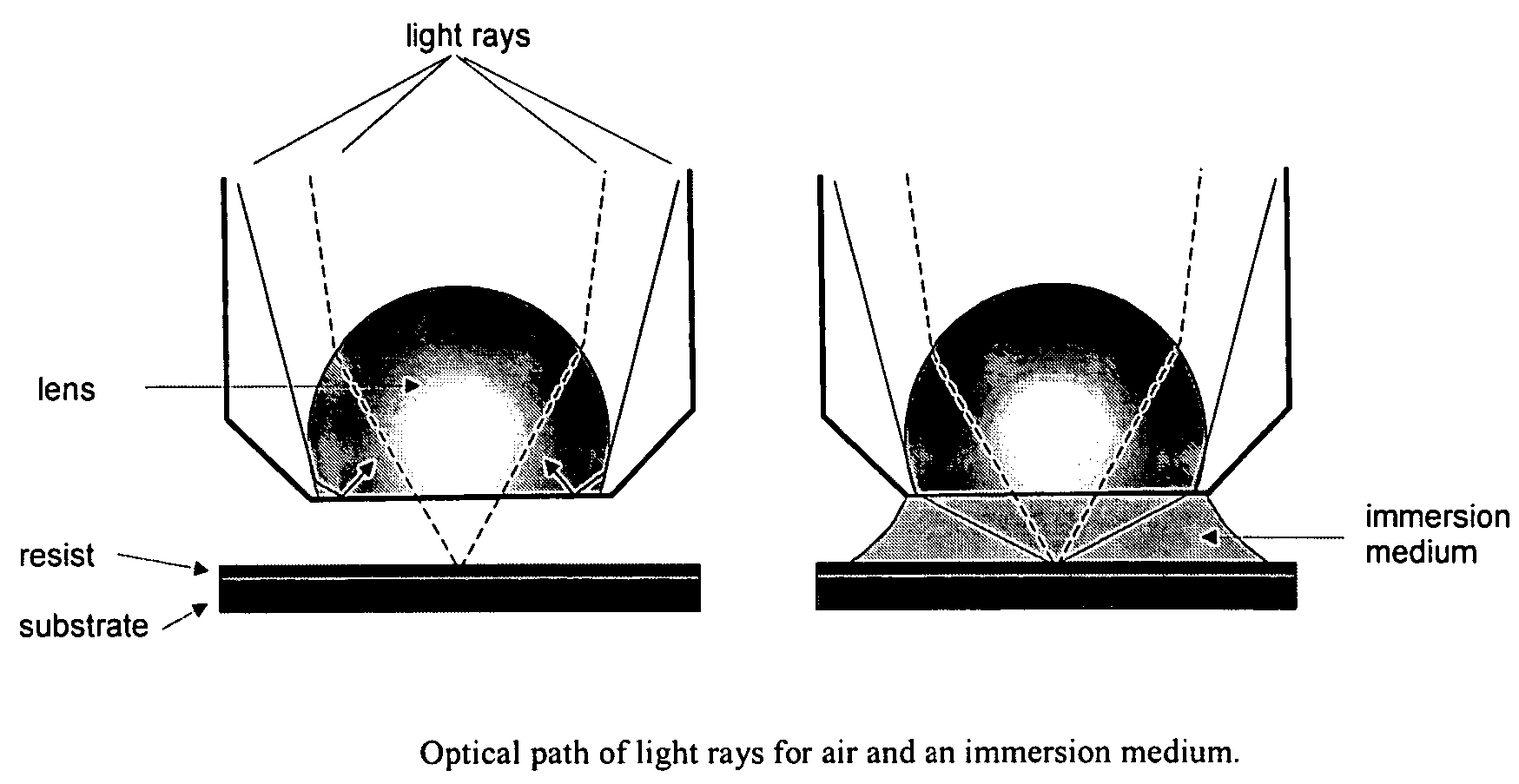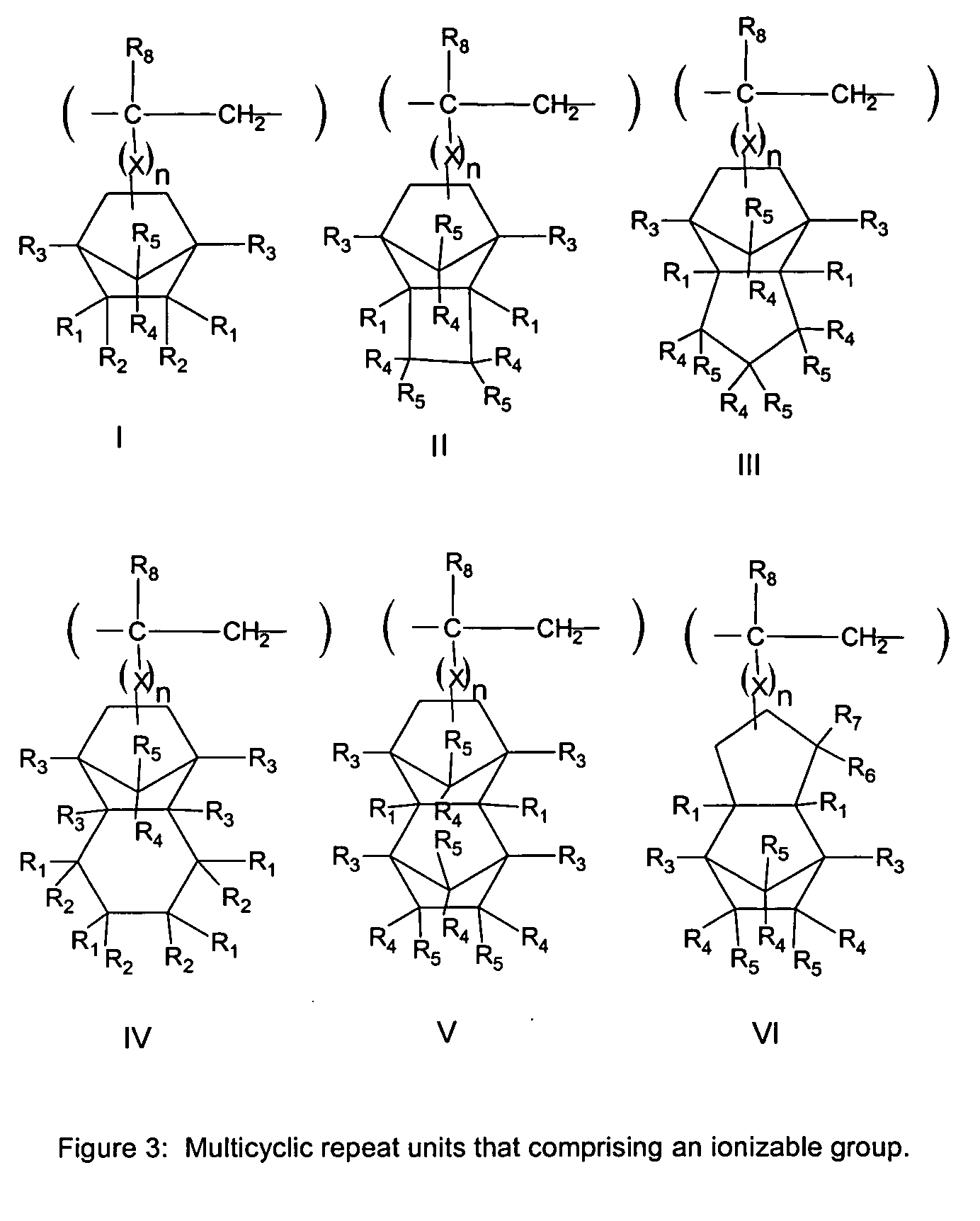Process of imaging a deep ultraviolet photoresist with a top coating and materials thereof
a technology of deep ultraviolet and photoresist, which is applied in the direction of photosensitive materials, auxillary/base layers of photosensitive materials, instruments, etc., can solve the problems of reducing the plasma etch resistance, removing the unexposed area of the coating, and forming a negative imag
- Summary
- Abstract
- Description
- Claims
- Application Information
AI Technical Summary
Benefits of technology
Problems solved by technology
Method used
Image
Examples
example 1
Synthesis of Polymer for Barrier Coating 1
[0074] The polymer, F-1 BNC (DUVCOR 385) (available from Promerus LLC 9921 Brecksville Rd, Bldg B Breckville, Ohio, 44141) was added as a dry powder to a round bottomed flask containing a magnetic stirring bar. The flask was fitted with a stopcock inlet and a vacuum of at least 5 torr was applied slowly. The flask was then immersed in an oil bath and stirred. The oil bath was then heated up to a temperature of 180° C. and the powder stirred at this temperature for 2 hours. After cooling, the powder was recovered. NMR and Infrared spectroscopic (IR) analysis revealed that the t-butyl group in the polymer had been completely removed (IR Shift of C═O band and disappearance of the CH bands and C—O band for ester, and disappearance of the tert-butyl ester CH3 peak). The material was recovered with a 95% yield. The reaction scheme for this procedure is shown below.
example 2
Synthesis of F-1 tert-butoxycarbonylmethyl (BOCME) Precursor to Barrier Coat 2
[0075] The polymer F-1, poly(3-(bicyclo[2.2.1]hept-5-en-2-yl)-1,1,1-trifluoro-2-(trifluoromethyl)propan-2-ol) Mw (10,000), (available from Promerus LLC 9921 Brecksville Rd, Bldg B Breckville, Ohio, 44141) (4.0 g, 14.59 mmol) was dissolved in 15 ml of tetrahydrofuran (THF) and solid tetramethylammonium hydrxide, TMAH.5H2O (0.793 g, 4.38 mmol) was added while stirring. After 30 minutes, t-butyl bromoacetate (1.71 g, 8.76 mmol) was added to this solution which was stirred for another 16 hours at 25° C. The precipitate formed in the reaction mixture was removed by filtration. The resultant filtrate was stripped of solvents in a rotary evaporator. The resultant residue was redissolved in 20 ml of MeOH containing 1.0 g of concentrated HCl. This solution was precipitated in 180 ml of water-methanol (8:1) mixture. The polymer was isolated by filtration and further purified by dissolving it into MeOH and re-precip...
example 3
Synthesis of F-1-CH2CO2H Barrier Coat 2
[0076] The polymer, F-1-BOCME made in Example 2 was added as a dry powder to a round bottomed flask containing a magnetic stirring bar. The flask was fitted with a stopcock inlet and a vacuum of at least 5 torr was applied slowly. The flask was then immersed in an oil bath and stirred. The oil bath was then heated up to a temperature of 140° C. and the powder stirred at this temperature for 1 hour at the oil bath temperature was raised to 180° C. and the powder stirred and heated for another hour at this temperature. After cooling, the powder was recovered. Infrared spectroscopic (IR) analysis revealed that the t-butyl group in the polymer had been completely removed (IR Shift of C═O band and disappearance of the CH bands and C—O band for ester, and disappearance of the tert-butyl ester CH3 peak). The material was recovered with a 95% yield. The reaction scheme for this procedure is shown below.
Equipment Used for Coating and Patterned Expos...
PUM
| Property | Measurement | Unit |
|---|---|---|
| exposure wavelength | aaaaa | aaaaa |
| exposure wavelength | aaaaa | aaaaa |
| pKa | aaaaa | aaaaa |
Abstract
Description
Claims
Application Information
 Login to View More
Login to View More - R&D
- Intellectual Property
- Life Sciences
- Materials
- Tech Scout
- Unparalleled Data Quality
- Higher Quality Content
- 60% Fewer Hallucinations
Browse by: Latest US Patents, China's latest patents, Technical Efficacy Thesaurus, Application Domain, Technology Topic, Popular Technical Reports.
© 2025 PatSnap. All rights reserved.Legal|Privacy policy|Modern Slavery Act Transparency Statement|Sitemap|About US| Contact US: help@patsnap.com



